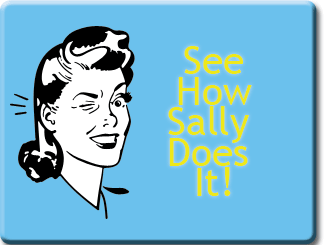Goals and Objectives Who is involved is just as important as what gets done because what gets done depends upon who is involved.
--Author unknown  Now that you've selected the specific KABB (knowledge, attitudes, beliefs and behaviors) factors that you want to focus on in your campaign, it's time to write your objectives and ask: What do you want to see as the outcome of this social marketing effort? Now that you've selected the specific KABB (knowledge, attitudes, beliefs and behaviors) factors that you want to focus on in your campaign, it's time to write your objectives and ask: What do you want to see as the outcome of this social marketing effort?
Goals are generally big, overarching statements about a project. Objectives are the smaller, measurable steps we use to acheive the goal. Objectives should follow the SMART format below:
S is for Specific - It is important to be specific in selecting the priority population and to focus on what behavior change is expected as a result of your campaign. [Note: remember the KABB factors you selected and stick to those.]
M is for Measurable - Make sure you can measure the intended change within a designated time frame. It is best to establish a baseline measurement to which you can compare behavioral change. In some social marketing campaigns, collecting baseline data and/or any evaluation data can be a bit of a challenge.
A is for Achievable - Make sure your objectives are reasonable and attainable within the time allotted and with the resources available.
R is for Relevant - Make sure each objective is related to the desired outcomes and overall goal.
T is for Time-framed - Have a clear, realistic time frame for each objective. And, organize all of your objectives in a time-line within a logical order.
A good guide for SMART objectives is to make sure you can answer the following questions:
By WHEN, WHO, WHERE will do WHAT by HOW MUCH?
1. WHEN: Describe the time frame for achieving the objective;
2. WHO: Identify the individuals expected to achieve the objective;
3. WHERE: Identify the specific geographic location;
4. WHAT: Describe the action or intended achievement;
5. HOW MUCH: Quantify the extent or degree of the achievement.
Below is the hierarchy of goals and objectives you should utilize when planning any intervention:
GOAL: A broad and ambitious statement of the ideal long-term impact of the intervention.
Example: Improve the overall sexual health of teens and young adults.
IMPACT OBJECTIVE: A focused and reasonable statement about the desired long-term impact of your program. The "who" is almost always the priority population with a health problem. Impact objectives are usually too broad to be the direct result of one program or campaign.
Example: By the year 2013, the overall gonorrhea incidence rate for 15- 24 year old African American youth in Gothem City will decrease from 1150 to 800.
[Note: you, your program, agency, and even your whole city are not responsible for goals and impact objectives alone because it's a group effort.]
OUTCOME OBJECTIVE: A focused, expected short-term outcome of your intervention based on a measured KABB change by the priority population. There are usually several outcome objectives which, cumulatively, should result in the achievement of the impact objective.
Example: By December 2011, at least 200 African American and Latino
youth (ages 15-24) in Gothem City, who saw the media campaign,
will report an increase in their intention to use condoms.
PROCESS OBJECTIVE: A specific, short-term activity usually conducted by program staff that is integral to accomplishing outcome objectives. Usually there is more than one process objective to support the achievement of an outcome objective.
Example: By September 2010, staff will conduct 4 focus groups with at
least 50 African American and Latino youth (ages 15-24) from Gothem City to gather qualitative information and input on the message content.
HERE'S A TIP: A series of process objectives can serve as the overall program plan. See the Strategy and Implementation section of the website for more examples and resources.
Don't fall into the Objective Pitfalls...
- Vague Factors: When the factor or indicator you want to change is not a measurable behavior. Things such as general "awareness" or feelings are difficult to quantify.
- No Baseline Measurement: When you can't answer the question, "compared to what?" If you do not have access to either personalized or general baseline data describing the Knowledge, Attitudes, Beliefs, or Behaviors (KABB) of the priority population, a retrospective evaluation may serve as an alternative. For example, you can ask them "before seeing this campaign..." what was the KABB compared to "after seeing this campaign..."
- Multiple Indicators: When there is more than one indicator in one objective. This is sometimes called a double-barreled objective (Ex: 75% of participants will report condom use at last sex and a reduction in the number of sex partners). In order to measure success in this objective, both behaviors would have to change by the same amount (75%). Separate each indicator to keep measures clear.
- Unrealistic Objectives: When the objective states something that is not a realistic, achievable outcome (Ex: 100% of the participants will use condoms 100% of the time).
- Confuses Process with Outcome: When an evaluation measures a process objective but considers it as an outcome or a population behavior change (Ex: 200 condoms were handed out to youth at a health fair).
- Inappropriate Time Frame: When not enough time is given for outcomes to occur (Ex: only allowing a few weeks for skill development or behavior change to occur).
 See Sally Formulate Goals and Objectives for Her See Sally Formulate Goals and Objectives for Her Social Marketing Campaign |